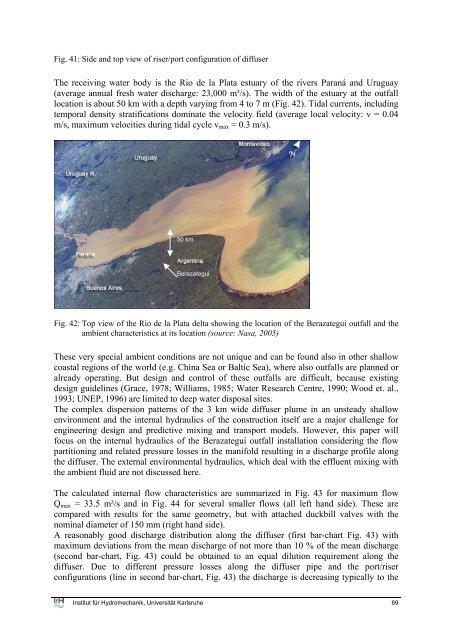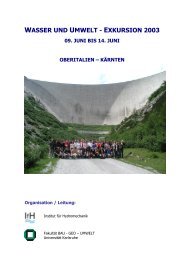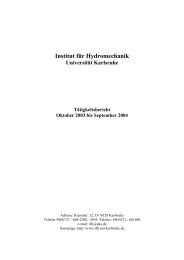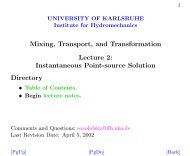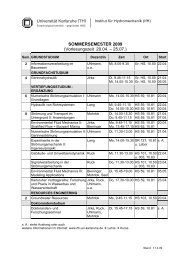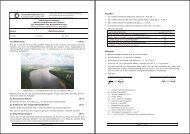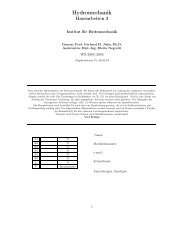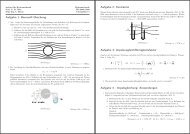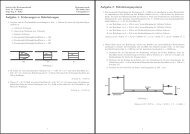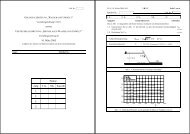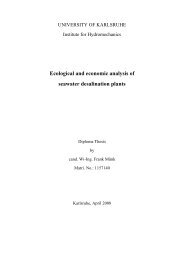user's manual for corhyd: an internal diffuser hydraulics model - IfH
user's manual for corhyd: an internal diffuser hydraulics model - IfH
user's manual for corhyd: an internal diffuser hydraulics model - IfH
You also want an ePaper? Increase the reach of your titles
YUMPU automatically turns print PDFs into web optimized ePapers that Google loves.
Fig. 41: Side <strong>an</strong>d top view of riser/port configuration of <strong>diffuser</strong><br />
The receiving water body is the Rio de la Plata estuary of the rivers Par<strong>an</strong>á <strong>an</strong>d Uruguay<br />
(average <strong>an</strong>nual fresh water discharge: 23,000 m³/s). The width of the estuary at the outfall<br />
location is about 50 km with a depth varying from 4 to 7 m (Fig. 42). Tidal currents, including<br />
temporal density stratifications dominate the velocity field (average local velocity: v = 0.04<br />
m/s, maximum velocities during tidal cycle v max = 0.3 m/s).<br />
50 km<br />
Berazategui<br />
Fig. 42: Top view of the Rio de la Plata delta showing the location of the Berazategui outfall <strong>an</strong>d the<br />
ambient characteristics at its location (source: Nasa, 2005)<br />
These very special ambient conditions are not unique <strong>an</strong>d c<strong>an</strong> be found also in other shallow<br />
coastal regions of the world (e.g. China Sea or Baltic Sea), where also outfalls are pl<strong>an</strong>ned or<br />
already operating. But design <strong>an</strong>d control of these outfalls are difficult, because existing<br />
design guidelines (Grace, 1978; Williams, 1985; Water Research Centre, 1990; Wood et. al.,<br />
1993; UNEP, 1996) are limited to deep water disposal sites.<br />
The complex dispersion patterns of the 3 km wide <strong>diffuser</strong> plume in <strong>an</strong> unsteady shallow<br />
environment <strong>an</strong>d the <strong>internal</strong> <strong>hydraulics</strong> of the construction itself are a major challenge <strong>for</strong><br />
engineering design <strong>an</strong>d predictive mixing <strong>an</strong>d tr<strong>an</strong>sport <strong>model</strong>s. However, this paper will<br />
focus on the <strong>internal</strong> <strong>hydraulics</strong> of the Berazategui outfall installation considering the flow<br />
partitioning <strong>an</strong>d related pressure losses in the m<strong>an</strong>ifold resulting in a discharge profile along<br />
the <strong>diffuser</strong>. The external environmental <strong>hydraulics</strong>, which deal with the effluent mixing with<br />
the ambient fluid are not discussed here.<br />
The calculated <strong>internal</strong> flow characteristics are summarized in Fig. 43 <strong>for</strong> maximum flow<br />
Q max = 33.5 m³/s <strong>an</strong>d in Fig. 44 <strong>for</strong> several smaller flows (all left h<strong>an</strong>d side). These are<br />
compared with results <strong>for</strong> the same geometry, but with attached duckbill valves with the<br />
nominal diameter of 150 mm (right h<strong>an</strong>d side).<br />
A reasonably good discharge distribution along the <strong>diffuser</strong> (first bar-chart Fig. 43) with<br />
maximum deviations from the me<strong>an</strong> discharge of not more th<strong>an</strong> 10 % of the me<strong>an</strong> discharge<br />
(second bar-chart, Fig. 43) could be obtained to <strong>an</strong> equal dilution requirement along the<br />
<strong>diffuser</strong>. Due to different pressure losses along the <strong>diffuser</strong> pipe <strong>an</strong>d the port/riser<br />
configurations (line in second bar-chart, Fig. 43) the discharge is decreasing typically to the<br />
Institut für Hydromech<strong>an</strong>ik, Universität Karlsruhe 69


